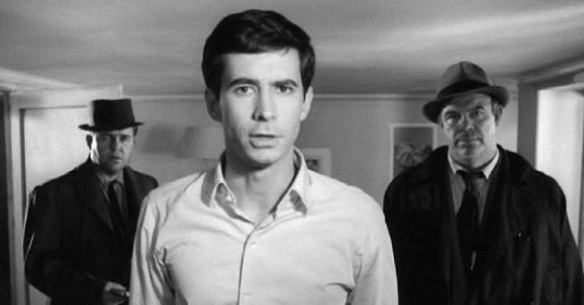It was just a dream. Or was it?

‘Josef K.’ in the film rendition of Franz Kafka’s The Trial
It woke me three nights ago, but it won’t go away. Against every conscious attempt to push it away, it is still demanding my full attention.
I had a headache that wouldn’t go away. A surgeon opened my brain and was pulling an animal from the side of my head: a big, brown rat, resisting the surprised surgeon’s efforts, and then another, while the other part of me in the dream watched and cringed. That was it. That was the dream.
From the time I was very young, nothing frightens me as much as a rat. I was five years old when I saw my first rat after the family moved into the 120 year-old house on Church Lane — the one with the open cistern and the huge hole in the basement wall. A rat would scurry across the kitchen floor after leaping from the kitchen cabinet my mother had just opened. At night I could hear the rats moving in the wall next to my bed in the upstairs bedroom. Occasionally a family cat would kill one and offer it to my mother as a present; the sight of the gift sent chills up my mother’s spine as much as if it had been alive. Mom was scared to death of rats. So was I.
The rats I learned to hate were not pet rats or the white rats of laboratory experiments. They were sewer rats who lived in the open cistern with the tunnel to our basement, like the beady-eyed creature that leaped at my father when he blew him out of the opening in the basement wall with a shotgun. I’ll be 76 in a few days, but in my mind, it happened yesterday.
Which brings me back to the brain surgery dream three nights ago. The pain in my head came from the rat that lived there. The rat wasn’t leaping from a cupboard or scurrying through the walls; it lived inside my head. I was helpless to remove it. It took surgical intervention, and its presence in my head surprised the surgeon as much as the part of me that was observing the procedure.
The rat represents everything I don’t want to be. It’s ugly. It’s dirty. It’s sneaky. It’s vile. It doesn’t operate in the daylight. It does it’s business in the dark of night. And, if you don’t kill it, it may kill you. Even if you shoot it, it will leap for your jugular.
It doesn’t take a Jungian dream interpreter to “get” the symbolism of the rat inside my head. I have been, and still am, my own worst enemy. You can run from the evil inside you, but the guilt remains. Betrayal, deceit, denial, divorce, hiding in kitchen cupboards, scurrying in bedroom walls, living in the cistern beside the house where the human beings live.
I’ve long known the truth of Carl Sandburg’s poem “The Wilderness”: “O, I got a zoo, I got a menagerie, inside my ribs, under my bony head…”. Like the rest of the human race, I, too, have a wolf in me, and a fox, a hog, a baboon, a fish, an eagle, and a mockingbird in me. But I have an animal not listed in Sandburg’s menagerie. I got a rat inside my bony head.
Childhood fears never die. And, like a former pope who hated his predecessor so much that he became him, if one isn’t careful, one becomes what one fears and hates.
Where is the surgeon who can remove it? What practices can pull the rat from my head and the free me of the horror inside my ribs? Or, is the challenge to live with it the same way I’ve come to terms with the other members of the menagerie of me — to go face-to-face, eyeball-to-eyeball, and, after all these years of running from it, muster the courage to make friends with my own worst enemy?

The rats of my childhood disappeared when the opening in the basement wall was closed with brick and mortar and the cistern was filled with concrete. It will take more than bricks and concrete to remove the one in my head, but the process has started, and for that, I’m thankful.
“The self is a relation which relates itself to its own self,” wrote Soren Kierkegaard in The Sickness Unto Death. I was both the subject and the object in the dream, the self relating to its own self. There is light in the darkness. Hope abounds.
Gordon C. Stewart, Chaska, MN, August 2, 2018.
